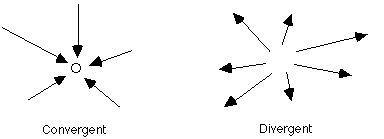
If the client has a specific issue she wants to work on we will usually work on that. We will apply techniques specifically to the task of resolving that issue. We start with a situation that has been at least loosely identified and we end with that situation having been changed into something more desirable.
If the client does not have any specific problem, we can address bigger, more general areas of life. Instead of using the client's specific situation as a starting point we would start with a more generalized view of what kind of things it would be nice to do or not do, and we introduce those areas to her and see what comes up.
We could call these two types of processes Specific and General processes. Those are not the perfect words but they give some idea of what we are dealing with.
It is almost always senior to deal with the actual person in front of you and what her situation is. So, if she has anything whatsoever that she would like to change, that is probably the best inroad we can get to doing something for her. It is right there on the surface, it is active, it has something to do with her life. If we change it, she will certainly notice and it will make a difference in her life. And since it is on the surface we will have a relatively easy time changing it, compared to stuff we have to dig up that she had no clue about.
But the person might not herself think about all the nice abilities and states of awareness that she could get. She just might not have gotten the idea that one could possibly be a totally flexible person, or that one could communicate comfortably with anybody, or that one could have extra-sensory perceptions. She might not consider herself as having a problem with these things and she might not be asking for change in those areas. But we know that if we introduce those areas to the person we can open up whole new areas of change for her.
Sometimes the most valuable change can be found in areas that the client didn't ask for and didn't know that she wanted.
We can also call these two types of processes Convergent and Divergent.

A process is convergent if it focuses on something specific, and when it has a fairly well-defined outcome. If we are working on a certain issue and we are working on finding out what it really is so that we can change it -- that is a convergent process. It goes towards a certain end-point.
A divergent process doesn't really know where it is headed. It might have a definite starting point, but from there it goes off into any direction. And any direction is as good as any other as long as some kind of positive change happens.
If the client comes in with a specific issue that is bothering him then we would be doing him a disservice by diverging off into something totally different. Even if we got some useful gain in another area. We would have cheated him out of the most available change. If he says "My wife doesn't understand me" and you say "What do you think about people?", that would be non-sequitur of course.
If the client doesn't have anything big on her mind, she might enjoy some off the wall question or idea that she had never thought of before. It might open up something new and unexpected. Since she probably didn't have any expectation about it, it doesn't really matter much what the new and unexpected stuff is. We might be just as happy with one thing as another.
"How long have you felt nervous like that?" is a specific, convergent question. There is something we are trying to find out and resolve. And it has to be that exact issue. We don't expect her to say "There is green cheese in the 5th dimension". We would keep her on the subject until we get some resolution into it.
"Who could communicate?" is a completely open-ended question. It is general, it doesn't refer to any specific situation. It can diverge into many directions. We are starting with the concept of communication and people who communicate, but really we can go all kinds of places from there. If she says that there is a green cheese in the 5th dimension that is communicating, that is fine. We might explore that further and see what we can get out of it.
General questions and directions are not given so much to get answers. They are given to open up new areas, to activate some subjects and issues, to make the person perceive things differently.
General processes often start with a certain subject or question. It might for example be a certain aspect of communication that we put attention on. We might word it quite precisely. However, from there we are not quite sure where the process will end or what kind of subjects will come up.
Specific processes often start with a fuzzy subject we know is there, but we don't really know quite what it is yet. During the process we will get closer and closer to pinpointing what is really going on.
It is quite likely that general process turn into more specific processes. Anything that is going on with the client is something specific. Our general questions might turn up all kinds of things, all of which are expected to be specific. Often all the client needs to do is to notice her own answers and learn from them. But sometimes we bring up some more heavy duty stuff and we might have to branch off to another technique that is more appropriate for handling it. Then when we are done we can go back to the general question and see what it now brings up.